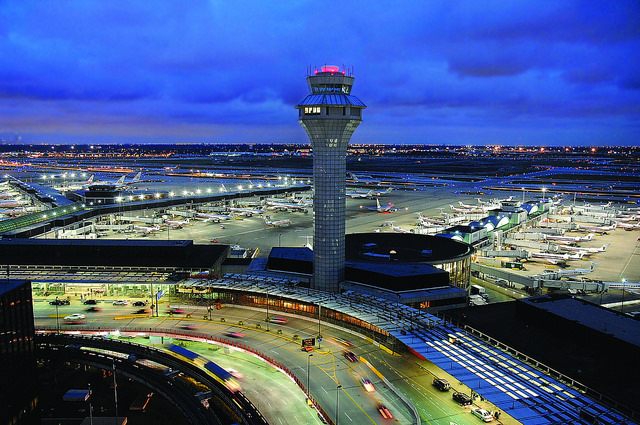
Mayor Rahm Emanuel introduced in February a historic plan between the City of Chicago and its airline partners that will create tens of thousands of jobs and transform O’Hare International Airport with the biggest terminal expansion ever, adding 25 percent more gate capacity, modernizing existing terminals and improving passengers’ experience.
“This plan is not just a game changer for O’Hare, it is a turning point for Chicago that will create tens of thousands of jobs for Chicagoans and strengthen our great city’s position as a national and global leader in travel, tourism and trade for generations,” said Mayor Emanuel. “My goal is to make O’Hare the best airport in the country, and I want to thank our airline partners for recognizing the value of this investment. We are looking forward to moving full steam ahead on this transformational plan that represents a watershed moment in Chicago’s economic future.”
The project will create 60,000 construction jobs through 2026 and ensures one of the City’s economic engines is positioned to drive significant growth for the region in the years and decades to come. With the plans outlined in the agreement, passengers traveling through O’Hare will enjoy better customer service, fewer delays, more choices for travel and a seamless journey to their destination.
The announcement marks the first major capital improvements to O’Hare’s terminals in more than 25 years. A new Terminal Area Plan for O’Hare will completely redevelop the terminals and concourses, with Terminal 5 to undergo an upgrade and expansion, Terminal 2 to be largely demolished and rebuilt to include a brand new international arrivals facility, and renovations made to Terminals 1 and 3. These changes will expand gate capacity and set in motion a wide range of other improvements to significantly enhance airline performance and the overall passenger experience.
Through a new capital program valued at more than $8.5 billion, O’Hare’s facilities will receive a major upgrade with the following benefits to passengers:
- A new world-class international terminal, called the O’Hare Global Terminal, will streamline customs and immigration processing using advanced technologies, creating a seamless experience for connecting passengers;
- O’Hare will rival U.S. hub competitors by becoming home to the first Global Alliance Hub in the country, giving passengers an easier connection to international destinations upon arrivals;
- State-of-the-art security screening that will further reduce wait times and allow passengers more time to relax, shop and dine;
- Three new state-of-the-art baggage systems; and
- New self-service technologies to make the flight check in process faster and easier for passengers.
The upgrades are set to grow O’Hare’s overall terminal square footage by more than 60 percent, from 5.5 to 8.9 million square feet, and increase gate frontage by 25 percent. More gate capacity will enable O’Hare and its airline partners to reduce delays by improving access to gates for arriving aircraft. This will also enable O’Hare to handle a wider range of aircraft more efficiently, including larger aircraft that allows more passengers to be served at O’Hare.
To support these critical infrastructure improvements, the City is seeking authority to issue up to $4 billion in bonds to help facilitate the start of these capital projects. This authority will provide flexibility to help the City and the Airlines minimize total financing costs and time bond issuances relative to expenditures and market conditions. The bonds will not be backed by taxpayer dollars; rather, they will be funded from O’Hare Aviation revenues, which include landing fees, terminal rent, and other fees paid by airlines, as well as non-airline sources, such as charges for parking and revenues from concessions in the terminals. The City plans to seek additional borrowing authority in the future as these capital projects move forward.
As O’Hare adds gates and improves its terminals, passenger volumes are expected to keep pace with a strong demand for air travel worldwide, which, according to aviation experts, will double to 14 billion air travelers in the next decade. By 2026, O’Hare is expected to serve nearly 100 million passengers, up from nearly 80 million served today. The economic impact on the region will be greater, with O’Hare 21 expected to provide at least $50 billion in economic contribution to the region, and to enable at least 460,000 jobs in the next eight years.
“This project will take real steps toward realizing western access at O’Hare, including employee parking and the first phase of a connecting tunnel. I appreciate the seriousness with which the City and the airlines are addressing this issue, which is good for the airport, local residents and the regional economy,” said DuPage County Chairman Dan Cronin.
With construction planned to begin next year, the Chicago Department of Aviation (CDA) and its partners across the city will establish a comprehensive workforce development program to connect residents to construction jobs and other airport employment opportunities. As projects are awarded, CDA will ensure that community hiring plans are in place and meaningful participation by MBE and WBE firms is achieved as a result of new contract provisions and programs instituted by the City of Chicago.
O’Hare’s expansion plans are being pursued by the City and the airlines as part of a new Use and Lease agreement, designed to replace the existing 35-year agreement that expires in May 2018. The new agreement establishes a more modern business arrangement to support O’Hare’s growing operations, with revised terms aligned to current industry standards.

